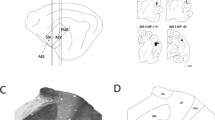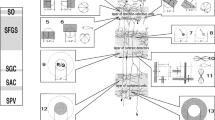Summary
Retinal inputs and their laminar distributions in the dorsal lateral geniculate nucleus (LGNd) of the eastern chipmunk (Tamias sibiricus asiaticus) were studied using histological and microelectrode recording techniques. A previous anatomical study (Fukuda et al. 1986a) indicated that the chipmunk LGNd had five laminae: contralaterally (contra) innervated lamina 1 and ipsilaterally (ipsi) innervated lamina 2 in its ventromedial part; laminae 3a (contra), 3b (ipsi) and 3c (contra) in its dorsolateral part. We have confirmed this finding in our present anatomical study and have also noted another ipsilaterally innervated thin lamina 0, medial to lamina 1. In our electrophysiological study, however, we were unable to record units from lamina 0 and to investigate it functionally. We recorded 232 units from laminae 1, 2 and the 3 complex, of which 95 were identified as Y-like, 46 as W-like, 15 as X-like, and 8 as mixed Y/W-like cells; the rest were either unclassified or visually unresponsive. In laminae 1 and 2, only Y-like and X-like cells were recorded, whereas in the laminae 3 complex W-like cells were recorded as well. The results suggest that the chipmunk laminae 1,2 and 3 complex correspond relatively well to the cat laminae A, A1 and C complex, respectively. In the chipmunk LGNd, however, there were more Y-like cells in laminae 1 and 2, and a few X-like cells of which some were color sensitive. Also, lamina 3a had a concentration of mixed-type cells with Y-like receptive field properties and W-like OX latencies. As for retinotopy, the dorsoventral transition of the contralateral visual field (laminae 1, 3a, 3c) is represented along the dorsoventral dimension of the chipmunk LGNd, whereas the temporonasal transition is represented in the rostrocaudal direction. Receptive field positions of the ipsilaterally innervated relay cells are limited to the central overlapping field of the contralateral visual fields of both eyes. Relay cells with visual fields having elevations of below -20° had relatively fast latency range and Ylike properties.
Similar content being viewed by others
References
Abplanalp P (1974) Topography of retinal efferent connections in sciurids. Brain Behav Evol 9: 333–375
Bowling DB, Michael CR (1984) Terminal patterns of single, physiologically characterized optic tract fibres in the cat's lateral geniculate nucleus. J Neurosci 4: 198–216
Conley M, Fitzpatrick D, Diamond IT (1984) The laminar organization of the lateral geniculate body and the striate cortex in the tree shrew. J Neurosci 4: 171–197
Conway JL, Schiller PH (1983) Laminar organization of the tree shrew dorsal lateral geniculate nucleus. J Neurophysiol 50: 1330–1342
Conway JL, Schiller PH, Mistler L (1980) Functional organization of the tree shrew lateral geniculate nucleus. Soc Neurosci Abstr 6: 583
Coway A, Perry VH (1979) The projection of the temporal retina in rats, studies by retrograde transport of horseradish peroxidase. Exp Brain Res 35: 457–464
Cusick CG, Kaas JH (1982) Retinal projections in adult and newborn grey squirrels. Dev Brain Res 4: 275–284
Dräger UC, Olsen JF (1980) Origins of crossed and uncrossed retinal projections in pigmented and albino mice. J Comp Neurol 191: 383–412
Dreher B, Sefton AJ, Ni SYK, Nisbett G (1985) The morphology, number, distribution and central projections of class I retinal ganglion cells in albino and hooded rats. Brain Behav Evol 26: 10–48
Fukuda Y, Sumitomo I, Sugitani M, Iwama K (1980) Distribution of fast and slow principal cells in the rat dorsal lateral geniculate nucleus. In: Ito M (ed) Integrative control function of the brain, Vol III. Kohdansha, Tokyo/Elsevier, Amsterdam, pp 72–74
Fukuda Y, Takatsuji K, Sawai H, Wakakuwa K, Watanabe M, Mitani-Yamanishi Y (1986a) Ipsilateral retinal projections and laminations of the dorsal lateral geniculate nucleus in the eastern chipmunk (Tamias sibiricus asiaticus). Brain Res 384: 373–378
Fukuda Y, Sawai H, Wakakuwa K, Watanabe M (1986b) Nasotemporal division of the monkey retina. Soc Neurosci Abstr 12: 636
Gabriel S, Gabriel H-J, Zippel U, Brandl H (1985) Regional distribution of fast and slow geniculo-cortical relay cells (GCR-cells) within the rat's dorsal lateral geniculate nucleus (LGNd). Exp Brain Res 61: 210–213
Guillery RW, Kaas JH (1974) The effects of monocular lid suture upon the development of the lateral geniculate nucleus in squirrels (Sciureus carolinensis). J Comp Neurol 154: 433–442
Hale PT, Sefton AJ, Dreher B (1979) A correlation of receptive field properties with conduction velocity of cells in the rat's retino-geniculo-cortical pathway. Exp Brain Res 35: 425–442
Harting JK, Huerta MF (1983) The geniculostriate projection in the grey squirrel: preliminary autoradiographic data. Brain Res 272: 341–349
Hayhow WR, Sefton A, Webb G (1962) Primary optic centers of the rat in relation to the terminal distribution of the crossed and uncrossed optic nerve fibres. J Comp Neurol 118: 295–322
Hebel R (1976) Distribution of retinal ganglion cells in five mammalian species (pig, sheep, ox, horse, dog). Anat Embryol 150: 45–51
Hsiao C-F, Fukuda Y (1984) Plastic changes in the distribution and soma size of retinal ganglion cells after neonatal monocular enucleation in rats. Brain Res 301: 1–12
Hughes A (1971) Topographical relationships between the anatomy and physiology of the rabbit visual system. Documenta Ophthalmol 30: 33–159
Hughes A (1977) The topography of vision in mammals of contrasting life style: comparative optics and retinal organization. In: Crescitelli F (ed) The visual system in vertebrates. Handbook of sensory physiology, Vol VII/5. Springer, Berlin, pp 613–756
Hughes A (1981) Population magnitudes and distribution of the major modal classes of cat retinal ganglion cell as estimated from HRP filling and a systematic survey of the soma diameter spectra for classical neurons. J Comp Neurol 197: 303–339
Hughes A, Whitteridge D (1973) The receptive fields and topographical organization of goat retinal ganglion cells. Vision Res 13: 1101–1114
Kaas JH, Guillery RW, Allman JM (1972a) Some principles of organization in the dorsal lateral geniculate nucleus. Brain Behav Evol 6: 253–299
Kaas JH, Hall WC, Diamond IT (1972b) Visual cortex of the grey squirrel (Sciurus carolinensis): architectonic subdivisions and connections from the visual thalamus. J Comp Neurol 145: 273–306
Kawamura S (1983) Visual pathways: geniculate and extra-geniculate systems (comparative aspect). Adv Neurol Sci 27: 703–717 (in Japanese)
Kirby MA, Clift-Forsberg L, Wilson PD, Rapisardi SC (1982) Quantitative analysis of the optic nerve of the North American opossum (Didelphis virginiana): an electron microscopic study. J Comp Neurol 211: 318–327
LeVay S, McConnell SK (1982) ON and OFF layers in the lateral geniculate nucleus of the mink. Nature 300: 350–351
Long KO, Fisher SK (1983) The distributions of photoreceptors and ganglion cells in the California ground squirrels, Spermophilus beecheyi. J Comp Neurol 221: 329–340
Lund RD, Lund JS, Wise RD (1974) The organization of the retinal projection to the dorsal lateral geniculate nucleus in the pigmented and albino rats. J Comp Neurol 158: 383–404
McConnell SK, LeVay S (1986) Anatomical organization of the visual system of the mink, Mustela vision. J Comp Neurol 250: 109–132
Provis JM (1979) The distribution and size of ganglion cells in the retina of the pigmented rabbit: a quantitative analysis. J Comp Neurol 185: 121–138
Provis JM, Watson CRR (1981) The distribution of ipsilaterally and contralaterally projecting ganglion cells in the retina of the pigmented rabbit. Exp Brain Res 44: 82–92
Rapaport DH, Wilson PD, Rowe MH (1981) The distribution of ganglion cells in the retina of the North American opossum (Didelphis virginiana). J Comp Neurol 199: 465–480
Reese BE, Cowey A (1986) Large retinal ganglion cells in the rat: their distribution and laterality of projection. Exp Brain Res 61: 375–385
Reese BE, Jeffery G (1983) Crossed and uncrossed visual topography in dorsal lateral geniculate nucleus of the pigmented rat. J Neurophysiol 49: 877–885
Schall JD, Perry VH, Leventhal AG (1987) Ganglion cell dendritic structure and retinal topography in the rat. J Comp Neurol 257: 160–165
Schiller PH, Malpeli JG (1978) Functional specificity of lateral geniculate nucleus laminae of the rhesus monkey. J Neurophysiol 41: 788–797
Stryker MP, Zahs K (1983) On and off sublaminae in the lateral geniculate nucleus of the ferret. J Neurosci 3: 1943–1951
Sugimoto T, Fukuda Y, Wakakuwa K (1984) Quantitative analysis of cross-sectional area of the optic nerve: a comparison between albino and pigmented rats. Exp Brain Res 54: 226–274
Tigges J (1970) Retinal projections to subcortical optic nuclei in diurnal and nocturnal squirrels. Brain Behav Evol 3: 121–134
Vaidya PG (1964) The retina and the optic nerve of the ground squirrel Citellus tridecemineatus tridecemlineatus. J Comp Neurol 122: 347–354
Wakakuwa K, Washida A, Fukuda Y (1985a) Ipsilaterally projecting retinal ganglion cells in the eastern chipmunk (Tamias sibiricus asiaticus). Neurosci Lett 55: 219–224
Wakakuwa K, Washida A, Fukuda Y (1985b) Distribution and soma size of ganglion cells in the retina of the eastern chipmunk (Tamias sibiricus asiaticus). Vision Res 25: 877–885
Wakakuwa K, Sumitomo I, Sugitani M, Fukuda Y (1987a) Retinal inputs to the geniculate relay cells in the eastern chipmunk (Tamias sibiricus asiaticus): a comparison between color and non-color sensitive cells. Brain Res 404: 211–220
Wakakuwa K, Watanabe M, Sugimoto T, Washida A, Fukuda Y (1987b) An electromicroscopic analysis of the optic nerve of the eastern chipmunk (Tamias sibiricus asiaticus): total fibre count and retinotopic organization. Vision Res 27: 1891–1901
Weber JT, Casagrande VA, Harting JK (1977) Transneuronal transport of [3H] proline within the visual system of the grey squirrel. Brain Res 129: 346–352
Wilson PD, Rowe MH, Stone J (1976) Properties of relay cells in cat's lateral geniculate nucleus: a comparison of W-cells with X- and Y-cells. J Neurophysiol 39: 1193–1209
Author information
Authors and Affiliations
Rights and permissions
About this article
Cite this article
Morigiwa, K., Sawai, H., Wakakuwa, K. et al. Retinal inputs and laminar distributions of the dorsal lateral geniculate nucleus relay cells in the eastern chipmunk (Tamias sibiricus asiaticus). Exp Brain Res 71, 527–540 (1988). https://doi.org/10.1007/BF00248745
Received:
Accepted:
Issue Date:
DOI: https://doi.org/10.1007/BF00248745




